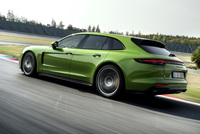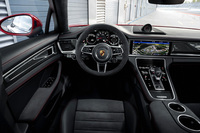Porsche Adds Two Extra Sporty Models to Panamera Line
460 Hp V8 Biturbo Engine, Sports Chassis and Wide Array of Equipment
 2019 Porsche Panamera GTS Sport Turbo |
Emotion and efficiency: V8 engine with 460 hp and sports exhaust system
At the heart of both of the new Panamera GTS models is a four-litre V8 engine with 338 kW (460 hp) of output and maximum torque of 620 Nm, cultivating an emotional sound and driving experience when combined with the
standard sports exhaust system. The biturbo engine, which features a gasoline particulate filter, outperforms its predecessor by 15 kW (20 hp) and 100 Nm, accelerating the Panamera GTS and Panamera GTS Sport Turismo from
0 to 100 km/h in 4.1 seconds as it works in conjunction with the standard Sport Chrono package. The two models achieve a top speed of 292 and 289 km/h respectively. There are no interruptions in tractive force as power
is transmitted to the Porsche Traction Management (PTM) all-wheel drive system by the eight-speed PDK dual clutch gearbox. Their exceptional performance is achieved with moderate consumption of just 10.3 l/100 km (Sport
Turismo: 10.6 l/100 km) (see footnote); the CO2emissions are 235 g/km (Sport Turismo: 242 g/km).
Performance and comfort: sports chassis with three-chamber air suspension
Designed to reflect the sporting prowess of the Panamera GTS models, the chassis systems are impressively dynamic. The adaptive air suspension with three-chamber technology is fitted as standard, which results in
flexible control and optimum spring rate spread. The sports chassis in the two GTS models has been lowered by 10 millimetres, while the Porsche Active Suspension Management (PASM) function has been adapted for an even
sportier calibration. The result? Outstanding lateral dynamics. Large brakes (390 millimetres in diameter at the front, 365 millimetres at the rear) deliver outstanding deceleration.
That distinctive GTS look: Sport Design package with black highlights
When compared to the predecessor, the new Panamera GTS models’ basic equipment package has been significantly upgraded in a number of areas. The Sport Design package with a new black front end, black trim at
the bottom of the rear, and a variety of darker elements highlights the more athletic appearance. The GTS models are equipped with 20-inch Panamera Design wheels as standard. The interior features hallmark elements
of black Alcantara and anodised aluminium. The standard package also includes a heated multifunction sports steering wheel with gearshift paddles and Alcantara trim and the Connect Plus module for a wide range of
digital services. With the optional Interior GTS package, drivers can customise their vehicle with various design elements, such as a rev counter, designer seams, and GTS logos in the contrasting shades of Carmine
Red or Crayon.
A first for the Panamera: head-up display with many configuration options
 2019 Porsche Panamera GTS |
Even better for day-to-day driving: the first ever Panamera GTS Sport Turismo
As is tradition at Porsche, GTS stands for Gran Turismo Sport. Porsche’s first road-approved sports car, the 904 Carrera GTS, was launched all the way back in 1963, bringing racing technology to the streets.
This was followed by the 924 GTS and 928 GTS, which cultivated the concept throughout the 1980s and 90s. In 2007, the GTS celebrated its revival with the Carrera GTS. The first generation of the Panamera GTS followed
in 2011, initially available as a sports saloon only. Now, the new Panamera GTS is also available as a Sports Turismo. With a large boot lid, low loading sill, increased luggage compartment volume and 4+1 seating
configuration, the new GTS variant based on the 2017 model meets the highest of standards for everyday driving, while also delivering outstanding performance.
The new GTS models are available to order now. In Germany, the Panamera GTS is available from EUR 138,493 including VAT and country-specific equipment; the Panamera GTS Sport Turismo is available from EUR 141,349.
The consumption and CO2 emission values were determined in accordance with the new Worldwide Harmonised Light Vehicle Test Procedure (WLTP). The NEDC values derived from this should continue to be specified for the time being. These values cannot be compared to the values determined in accordance with the NEDC measuring procedure used up to now.



